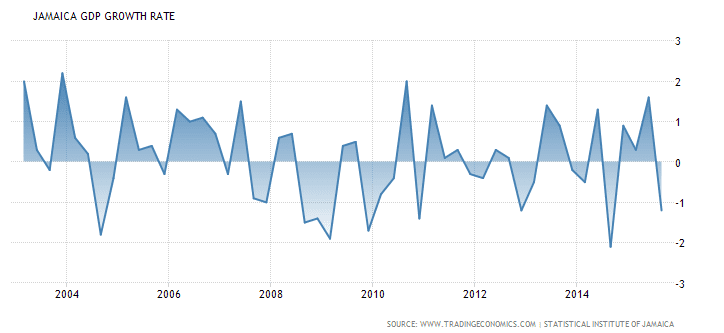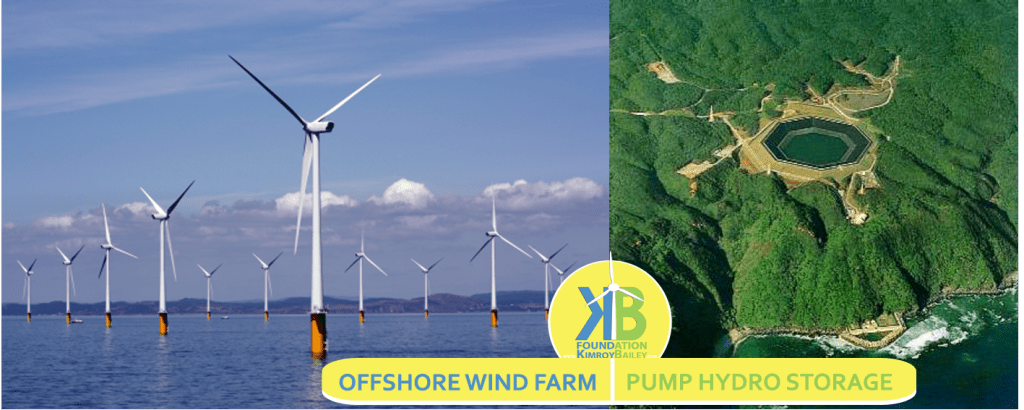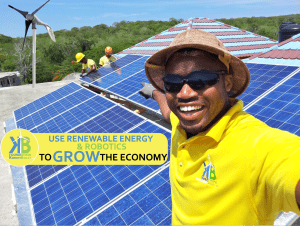Renewable Energy & Robotics to Grow the economy
Renewable Energy & robotics can significantly grow the Jamaican economy. Forty years of a mere 0-1% growth has forced a mass migration of young intellectuals to work in other countries and build their economies. This article challenges the leaders of Jamaica to pursue renewable energy & robotics to achieve momentous economic growth capable of returning our country to the glorious economic days of the 17th century. In the early days when Jamaica was Queen, major cities in the even mighty United States struggled to keep up with her rate of development. Black River received electricity before Los Angeles [1, 2], Falmouth received piped water before New York [3] and Port Royal was one of the busiest hub in the western hemisphere [4]. Sugar was king, rum was queen, and coffee and banana were the prince and princess of the land.

The first goal to return Jamaica to her economic prowess is to capitalize on the vast renewable energy resources to replace the usage of imported oil for electricity generation. Parallel to the reduction of oil importation is the second goal of integrating robotics in education to advance the development of technological products to diversify our export portfolio. Renewable energy & robotics as strategic objectives will not only aid the energy and manufacturing sectors but will also significantly impact education, agriculture, crime fighting, tourism and the logistics hub initiative.
Replace oil importation with Renewable Energy
In 2013 the Development Bank of Jamaica indicated that Jamaica earned U$1.54B from exports but spent 4 times as much on imports at a whopping U$6.18B. Almost $2.5B of our import bill was spent on oil, majority of which is used for electricity generation [5] . In that year Jamaica’s economy grew by less that 1% [6]. The land of sun, sand, sea and sea breeze, our first goal is to stop importing oil for electricity generation and instead power our country with wind and solar energy. A 100% Renewable Jamaica is not only reliable but it will also pay for itself within 5 years and reduce our oil import bill by more than U$0.5B annually. Powering a country exclusively by renewable energy is nothing new; Costa Rica has already done it while Denmark, Norway, Iceland and Germany are well on the way to become 100% renewable energy powered [7]. Interestingly, none of these countries have more solar exposure and access to coastal wind than Jamaica due to our proximity to the equator and as a country surrounded by water. Ignoring our renewable energy potential is like preparing a nice lunch for your child to go to school and giving him $5. He borrows $10 from his classmate and spends $15 for lunch. At the end of the day he comes home, $10 in debt and his lunch still tucked away. Strong sea breeze and bright sunny days is the warm lunch Jamaica has tucked away yet we borrow left and right to pay for imported oil, a commodity we can’t afford and can easily replace.

Placing wind turbines in the sea to generate energy from the wind is called an offshore wind farm. Two hundred wind turbines in the sea, each producing 5MW of power, will collectively generate 1GW of electrical energy. These turbines are sufficient to reliably supply the 700MW of power the island currently consumes and will only utilize 2 square miles of sea water along our south coast where offshore wind is strongest. The excess 300MW will be stored by powering a hydro generator to pump sea water 200m above sea level in a back up reservoir. Allowing the water from the reservoir to gravity feed 200m downhill through the hydro generator will maintain energy generation whenever the wind speed is low or additional capacity is needed. This offshore wind farm and reservoir facility will eliminate the need for 5 of the 13 million barrels of oil imported annually.
Recommended for You: 100% Renewable Jamaica

Solar cells and DC motors should be widely distributed for home owners to assemble their own solar panels and homemade wind turbines. This will considerably reduce the price for home owners to be independent of the grid to an estimated average of J$450,000. Television and radio programs should educate persons on simple steps to install renewable energy systems at home. Solar and wind installations must be marketed as a family activity, where home owners assist technicians to reduce labor cost. The cost for substituting oil with renewable energy via the offshore wind farm and the renewable home campaign is estimated to cost U$2.5B. This will reduce annual oil importation by more than $0.6B annually thus paying for itself in less than 5 years while the country continues to benefit from relatively free electricity from wind and solar energy thereafter.
Robotics in Education to incubate innovations for export
Reducing the amount our country spends on importation is as important as increasing the amount earned from exportation, consequently our second goal in our Renewable Energy & Robotics strategy is the integration of robotics in education. Robotics in education will reverse the trend of declining performance across Science, Technology, Engineering and Mathematics (STEM) related subjects. These STEM subjects are the heartbeat of innovation, manufacturing and the production of value added products for export. The 2015 results released by the Caribbean Examination Council indicated that grades for mathematics, biology, chemistry and physics declined by 7.7%, 9%, 13.5% and 15.5% respectively. The ancient teaching methodology of textbook, assignments and exams have made it difficult for students to grasp pertinent topics in STEM subjects; it is now time to teach the way students learn. Research done by The Education Archive shows that students who are able to touch and interact with science and technology through educational robotic kits perform significantly better at STEM subjects when compared to traditional teaching techniques [8]. Instructors dangle the carrot of “one day you will see how this topic might be applicable in your career”, for many students that day never come. Educational robotics kit brings science to life; this aids the teacher in their delivery while benefiting the student in understanding the application of core science concepts.

Recommended: Summer Youth Renewable Robotics Camp
The integration of educational robotics kit in the curriculum can be financed through cost sharing where the government covers 40% of the cost for the educational robotics kit and parents absorb the remaining 60%. This will ensure that all students have the opportunity to own an educational robotics kit and will cost the economy U$5M. Distributing gadgets to students is not a new strategy as demonstrated by the Tablet in School program launched in 2014 which cost the country J$1.4B [9]. The economy will recoup these investments via taxing exports of robotics and technology based products made in Jamaica by the beneficiary of the robotics in education program. This hands-on approach to education through robotics provides the platform for students to develop the Facebook, Apple or Google of Jamaica. Technology base companies will make a significant contribution to the growth of our economy. Forbes magazine highlighted that Apple paid the US government U$8.3 billion in taxes in 2011 [10]. That’s sufficient funds to sustain Jamaica’s importation bill for a year and a half.
Renewable Energy & Robotics will grow Jamaica by more than 5%
The strategy of capitalizing on Renewable Energy & Robotics is based on the economic principle of spending less while earning more. Renewable Energy will allow Jamaica to spend less on imports while robotics allow us to earn more from exports. Besides the core sectors of energy and manufacturing the ripple effect of these two goals will aid agriculture, crime prevention, tourism and the logistics hub initiative. Advance agricultural products will make their ways to shelves across the world. Cutting edge aerial robotic platforms will be deployed for home protection and volatile area surveillance thus protecting our citizens and boosting our tourism industry. Jamaica is poised to join Singapore, Dubai and Rotterdam in the global logistics hub. Innovative Jamaican companies will be able to make robotic and automated products to boost our efficiency and competitiveness in the logistics initiative. Renewable energy and robotics will allow talented individuals to secure quality jobs for quality compensation and grow the economy by 5%-7% annually. Above all, these two goals will allow our beautiful piece of paradise to become the place of choice to live, work, raise families and do business. May God continue to bless our country, our people and our leaders.






Comments (3)
I wish to learn on solar installations as well as sslling the products both in retail on whole sale in East Africa
Proud of my country and the students that participate in such invention making the country more recognized and appreciate who we are..
Hi Kimroy
The views shared by you are quite impressive. These two techniques can certainly help in retaining Jamaican youth in their country. The leaders should certainly pay attention towards it.